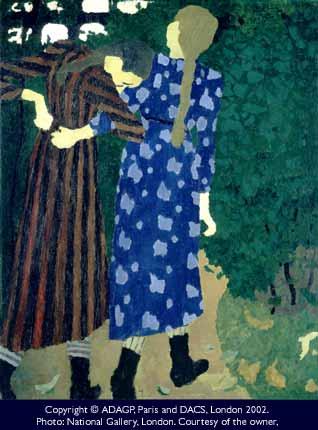Fabric of Vision
dal 18/6/2002 al 8/9/2002
Segnalato da
18/6/2002
Fabric of Vision
The National Gallery, London
Dress and Drapery in Painting. This unique exhibition looks at the ways artists from the Renaissance to the 20th century have used clothing and drapery in their paintings to express emotion and create drama. It includes a stunning array of masterpieces by some of the greatest European painters, from Mantegna and Caravaggio to Matisse and Modigliani.

Dress and Drapery in Painting
This unique exhibition looks at the ways artists from the
Renaissance to the 20th century have used clothing and
drapery in their paintings to express emotion and create
drama. It includes a stunning array of masterpieces by
some of the greatest European painters, from Mantegna
and Caravaggio to Matisse and Modigliani.
Artists bring dress and drapery to life, showing us how to
see and feel it. In responding to contemporary fashion,
they present to each age a compelling image of how
clothes should be worn. The exhibition opens with a
striking series of paired paintings of clothed and nude
women, by such artists as Veronese, Tintoretto, Van
Dongen and Bonnard, showing how the prevailing fashion in
clothing even determines how the naked female body is
represented and made to appear desirable.
In the early Renaissance, artists respected the actual
nature and behaviour of cloth, and looked back to the
sculpture of classical antiquity for examples of how it
should be depicted.
From the 16th century onwards, in the
work of such painters as Tintoretto and El Greco drapery
took on a life of its own, filling canvases with impossible
swirls and billows, and communicating intense emotions.
In
Caravaggio's Boy bitten by a Lizard, the white shift falling
from the boy's shoulder as he starts back in pain
underscores the mood of bittersweet sensuality, an effect
echoed centuries later in Cindy Sherman's self-portrait
photograph.
During the 18th century, in history paintings
by Fragonard and Tiepolo and portraits by Reynolds and
Zoffany these effects grew ever more theatrical, until the
neo-classical revolution introduced a new taste for
simplicity in dress, designed to suggest the naked form
beneath the clothes. The evolution of the tailored suit
with its suggestions of virile masculinity can be traced in
Delacroix's romantic portrait of Baron Schwiter, Lehmann's
portrait of Liszt and Munch's 1906 portrait of Harry Graf
Kessler.
During the 19th century, painters such as Tissot and
Toulouse-Lautrec made much of the contrast between
soberly dressed men and flamboyantly clothed women,
while others including Corot and Alfred Stevens explored
the psychological implications of pensive, solitary women in
fashionable outfits, a subject later taken up by
photographers. The exhibition concludes by showing how
with the onset of the 20th century the representation of
fabric became subordinated to the artists' formal pictorial
concerns, and the free display of paint itself. In works by
Vuillard and Matisse, dress and drapery are suggested, not
described, by expressive patterns of flat colour and
serpentine line.
The exhibition is conceived and curated by the art
historian, critic and historian of dress, Anne Hollander.
Exhibition opening hours:
Daily 10am- 6pm
Wednesdays until 9pm
Last admissions 5.15pm and 8.15pm.
For any further information about the exhibition please contact the Information Department.
Telephone: 020 7747 2885
National Gallery
Trafalgar Square WC2N 5DN
London



